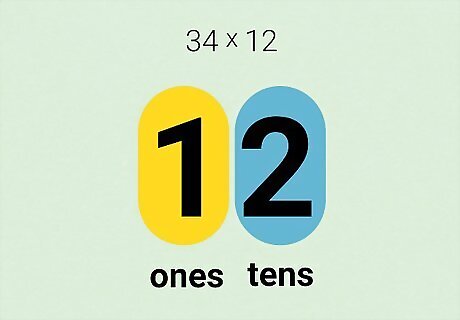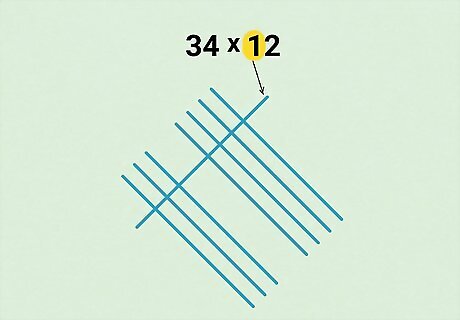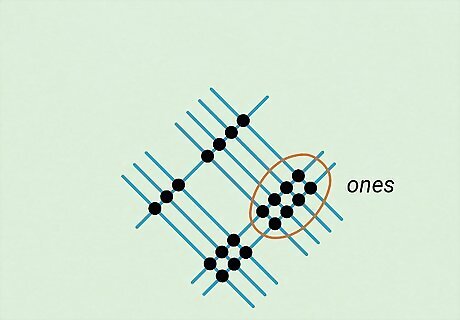
views
X
Research source
Chinese, or Vedic cultures. It is basically the same process as the standard multiplication algorithm you are taught in school, except it is represented in a more visual way. Using the intersection of lines or sticks to represent where you multiply various place values, this method might be helpful for those learners who are more visually-oriented.
Setting Up the Problem

Determine the place values of your first number. You need to know how many places are in your number, and what digit is in each place. For example, if you are multiplying 34 × 12 {\displaystyle 34\times 12} 34\times 12, you would determine that the first number, 34, has a 4 in the ones place, and a 3 in the tens place.

Draw parallel lines to represent the tens place of your first number. The number of lines you draw will correspond to the digit in the tens place. Draw the lines at about a 45 degree angle, slanting down towards the right. For example, if you are representing 34, you would draw 3 parallel lines.

Draw parallel lines to represent the ones place of your first number. The number of lines will correspond to the digit in the ones place. Draw these lines above and to the right of the tens lines. Leave some space between the ones lines and the tens lines, so you can tell them apart. For example, if you are representing 34, you will draw 4 parallel lines.

Determine the place values of your second number. You need to know how many places are in your number, and what digit is in each place. For example, if your second number is 12, you would determine that you have a 2 in the ones place, and a 1 in the tens place.

Draw parallel lines to represent the tens place of your second number. The number of lines will correspond to the digit in the tens place. Draw the lines near the top of the diagram. They should cross all the lines of the first number, slanting in the opposite direction. It might be helpful to draw each number’s lines in a different color. For example, if you are representing the number 12, you would draw 1 parallel line crossing over the sets of lines from the first number.

Draw parallel lines to represent the ones place of your second number. The number of lines will correspond to the digit in the ones place. Draw the lines below the ones lines, so that they cross over all the lines of the first number, slanting in the opposite direction. Leave some space between the ones lines and the tens lines, so you can tell them apart. For example, if you are representing 12, you will draw 2 parallel lines below the 1 line you drew for the tens place.

Draw dots on each point where the lines intersect. In the line multiplication method, you will be adding up these lines instead of doing any actual multiplying.
Solving the Problem

Circle the set of dots representing the ones place. These are the dots formed at the intersection where the ones lines for each number intersect. Think, “A one times a one equals a one.” For example, for 34 × 12 {\displaystyle 34\times 12} 34\times 12, you would circle the dots formed where the 4 lines intersect with the 2 lines, which are in the set on the right side of the diagram.

Circle the two sets of dots representing the tens place. These are the dots formed when the ones digit of either number intersects with the tens digit of the other number. Think, “A one times a ten equals a ten.” For example, for 34 × 12 {\displaystyle 34\times 12} 34\times 12, you would circle the dots formed where the 1 line intersects with the 4 lines, and where the 2 lines intersect with the 3 lines, which are in the middle of the diagram.

Circle the set of dots representing the hundreds place. These are the dots formed at the intersection where the tens lines for each number intersect. Think, “A ten times a ten equals a hundred.” For example, for 34 × 12 {\displaystyle 34\times 12} 34\times 12, you would circle the dots formed where the 3 lines intersect with the 1 line, which is on the left side of the diagram.

Add up the dots in the ones place. These are the dots you circled on the right side of the diagram. This number will be in the ones place of your answer. For 34 × 12 {\displaystyle 34\times 12} 34\times 12, you should count 8 dots. So 8 {\displaystyle 8} 8 will be the digit in the ones place of your final answer.

Add up the dots in the tens place. These are the two sets of dots in the middle of the diagram. This number will be in the tens place of your answer. For 34 × 12 {\displaystyle 34\times 12} 34\times 12, you should count 10 dots. Just like any time you add or multiply, once a digit in any place value reaches 10, you need to carry. So, if you count 10 for the tens place, you would place a Failed to parse (MathML if possible (experimental): Invalid response ("Math extension cannot connect to Restbase.") from server "https://wikimedia.org/api/rest_v1/":): {\displaystyle 0} in the tens place, and carry the 1 over to the hundreds place.

Add up the dots in the hundreds place. These are the dots you circled on the left side of the diagram. This number will be hundreds place of your answer. For 34 × 12 {\displaystyle 34\times 12} 34\times 12, you should count 3 dots. Don’t forget to add any amount you carried over. For 34 × 12 {\displaystyle 34\times 12} 34\times 12, you carried over a 1 from the tens place, so calculate 3 + 1 = 4 {\displaystyle 3+1=4} 3+1=4. So 4 {\displaystyle 4} 4 will be the digit in the hundreds place of your final answer.

Determine your final answer. Put together all the digits you found for each place value. For example, for 34 × 12 {\displaystyle 34\times 12} 34\times 12, you determine an 8 {\displaystyle 8} 8 goes in the ones place, a 0 {\displaystyle 0} {\displaystyle 0} goes in the tens place, and a 4 {\displaystyle 4} 4 goes in the hundreds place. So your final answer is 408 {\displaystyle 408} 408.

















Comments
0 comment